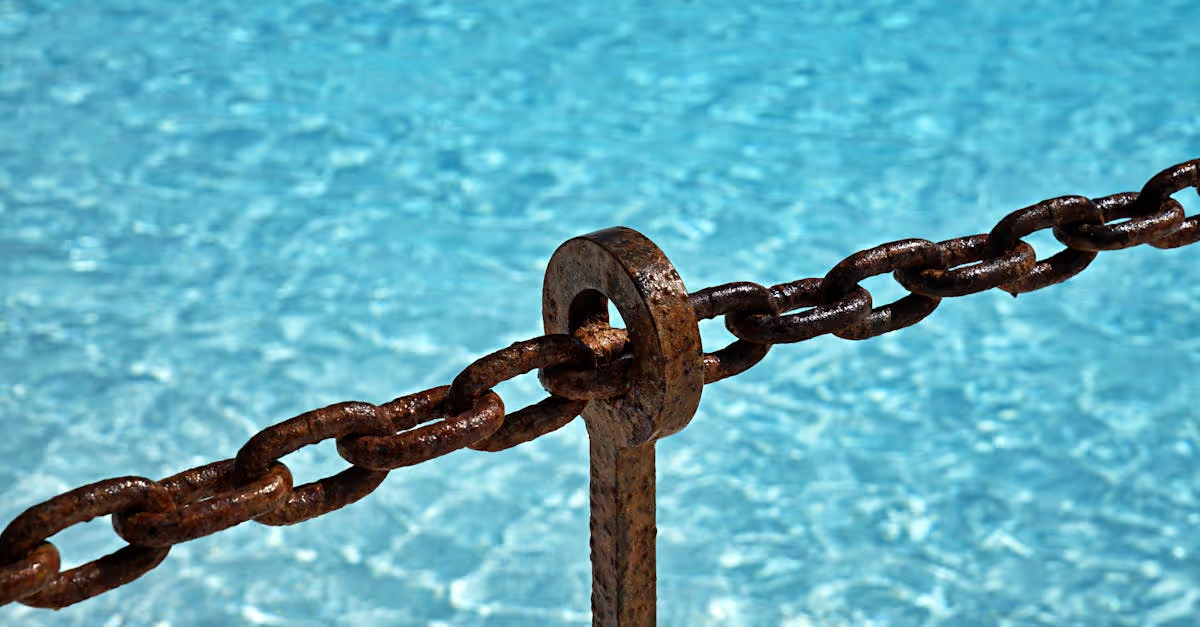Key Takeaways
- Proper winter storage of pool equipment can extend its lifespan by reducing wear and tear, potentially saving you significant expenses.
- Cleaning and drying items like filters, pumps, and covers before storing prevents rust, mold, and other damage during winter months.
- Disassembling larger equipment and organizing smaller components in labeled bags makes storage easier and prevents breakage.
- Choose a dry, climate-controlled storage location to protect equipment from harsh winter conditions, using pallets or shelves to keep items off concrete floors.
- Regular inspections and maintenance, such as checking for damage and cleaning before storage, are essential practices to ensure functionality when spring arrives.
As winter approaches, it’s crucial to think about how we store our pool equipment. Did you know that improper storage can reduce the lifespan of our gear by up to 50%? Taking the time to prepare our equipment for the colder months not only protects our investment but also ensures that we’re ready to dive back in when warmer weather returns.
From pool covers to pumps and filters, each piece of equipment has specific needs during winter. By following the right steps, we can shield our gear from harsh conditions and keep it in top shape for years to come. Let’s explore the best practices for winter storage that will help us maintain our pool equipment efficiently and effectively.
Importance of Proper Storage
Properly storing pool equipment as winter approaches plays a crucial role in extending its lifespan. Without careful preparation, equipment like pool covers, pumps, and filters face potential damage, leading to unnecessary expenses and hassle come spring.
Protecting Against Weather Damage
Protecting pool equipment from harsh winter conditions significantly reduces the risk of deterioration. Moisture, freezing temperatures, and heavy snow can lead to rust, mold, or cracking. For instance, storing pumps in a dry, climate-controlled space helps keep the internal components in optimal shape. It’s wise to remove electrical connections to avoid corrosion, ensuring smooth operation once the warm weather returns. Let’s face it—no one wants to deal with a clogged pump or a ripped pool cover when prepping for pool season. Imagine starting a summer party with faulty equipment; that scenario’s enough to make us all cringe. What strategies do we all use to safeguard our investments during the snowy months?
Preventing Wear and Tear
Preventing wear and tear on pool equipment is essential for longevity. Clean and dry items thoroughly before storage to prevent mold and mildew buildup. For example, filters benefit from a good rinse and thorough drying, making them last longer. Additionally, consider using protective covers for furniture and accessories to shield them from the elements. These small steps add up, saving us time and money in potential repairs later on. Did you ever leave garden furniture out in the winter only to find it looking like an alien artifact in spring? We know the feeling! By taking proactive measures now, we set ourselves up for success next season. What are your best tips for winter equipment care?
Essential Steps for Winter Storage
Proper winter storage of pool equipment can vastly extend its lifespan. Following these steps keeps our gear in top shape for the next swimming season.
Cleaning Pool Equipment
Cleaning pool equipment is vital for preventing rust and mold during winter. We start by cleaning the pool vacuum hose. Draining as much water as possible prevents freezing damage. We store the hose straight or disassemble it to avoid kinks. Next, we remove all accessories like ladders, skimmers, and hoses, cleaning and inspecting each for any wear and tear. Finally, for the pool pump and filter, we need to remove any accumulated dirt. Afterward, letting them dry completely before storage keeps them in good condition.
Disassembling Components
Disassembling components aids in efficient storage. We take apart larger items like the pool ladder or slide to fit them into tighter spaces. This practice not only saves room but also guards against potential breakage. Additionally, we store smaller components, like adapters and plugs, in labeled bags. Labeling helps us quickly find items come springtime.
Choosing the Right Storage Location
Selecting a suitable storage location is equally important. We opt for a dry, climate-controlled space to protect our equipment from harsh conditions. A garage or basement often works well. If that's not an option, a dry shed can suffice—a little insulation never hurts! Keeping items off concrete floors with pallets or shelves prevents moisture exposure. This attention to detail safeguards our gear from unwanted issues over winter.
By diligently following these steps, we pave the way for a smooth transition back to pool enjoyment when the sun comes out again.
Best Practices for Each Type of Equipment
Properly storing pool equipment extends its lifespan, making our pool time enjoyable when warmer weather arrives. Let’s dive into the best practices for different types of equipment.
Storing Pool Pumps and Filters
We must focus on our pumps and filters during winter storage. Drain the pump completely to prevent any water freezing inside, which could cause damage. Clean dirt off the pump and allow it to dry thoroughly. Disconnect the pump from its base and store it in a protective area like a shed or basement, keeping it off the ground and away from foot traffic. In cases where disconnection isn’t possible, wrapping the motor and using a hard cover provides necessary protection. For filters, the approach can vary. With sand filters, it's crucial to drain all water by opening the drain cap at the bottom and leaving it off while stored. These details make the difference in our spring opening routine.
Care for Pool Covers
Protecting our pool covers matters too. Start by cleaning the covers from any debris like leaves or dirt. It's important to dry them completely before folding and storing them. Store the covers in a dry area to prevent mold growth. Using a labeled bag helps keep track of different covers, making it easier to find the right one once the temperature rises. If we find any tears or damage, repairing them before storing keeps our covers in good shape for next season.
Managing Chemicals and Accessories
Our chemical storage needs special attention as well. Always keep chemicals in their original containers, tightly sealed to prevent spills. Store them in a cool, dry place out of reach of children and pets. A locked cabinet can add an extra layer of safety. For accessories like pool skimmers, brushes, and vacuums, cleaning them before storage prevents residue buildup and extends their life. Organizing these items in labeled bins makes retrieval simple when it’s time to reopen the pool. By taking these steps, we can enjoy safe and fun pool days ahead.
Maintenance Tips for Equipment Longevity
Taking proper care of pool equipment during winter promotes its longevity and functionality. Following these maintenance tips helps us protect our investments and enjoy our pools when warmer days return.
Regular Inspections
Regular inspections play a crucial role in maintaining pool equipment. A quick check can reveal hidden issues like cracks, leaks, or wear. Inspect after each use and before storing for the winter. Look for water pooling, rust spots, or any signs of damage. Identifying these issues early can prevent bigger headaches later on. Sometimes, we overlook minor wear and tear that turns into significant problems. Make inspections a routine part of our pool care, just like checking the weather before a swim.
Proper Maintenance Before Storage
Proper maintenance before storing equipment can go a long way. Cleaning each item ensures no debris or grime is left behind. For our hoses, we should drain as much water as possible to prevent freezing. Let’s scrub them down and allow them to dry completely. We can store hoses straight or disassembled in sealed containers to avoid kinks. For pool pumps, draining them fully avoids potential freeze damage. We must also wipe down surfaces, as trapped moisture can lead to mold when everything is packed away. Think of this process as putting our pool equipment to bed for winter; the better we prepare them now, the happier they'll be when we wake them up come spring!
By integrating these regular inspections and maintenance steps, we actively contribute to the longevity of our pool equipment and prepare for a smooth transition back into pool season.
Conclusion
By taking the time to properly store our pool equipment during winter, we can significantly extend its lifespan and ensure it's ready for use when warmer weather returns. Implementing the steps outlined in this guide not only protects our investment but also saves us from costly repairs in the spring.
Let’s prioritize cleaning and drying our equipment thoroughly, disassembling larger components, and storing everything in a climate-controlled space. Regular inspections and maintenance throughout the year will help us catch any potential issues early on.
With the right care and attention, we can enjoy our pools to the fullest when the season changes. Let's embrace these practices and make the most of our outdoor enjoyment for years to come.
Frequently Asked Questions
How should I store pool equipment for winter?
Properly store pool equipment by cleaning and drying all items thoroughly, disassembling larger parts, and storing smaller items in labeled bags. Utilize a dry, climate-controlled space to protect against harsh winter conditions.
Why is cleaning pool equipment important before storage?
Cleaning pool equipment before storage helps prevent rust, mold, and mildew buildup. Thorough cleaning ensures that dirt and debris don’t cause damage during the winter months.
What precautions should I take for pool pumps and filters?
Drain pool pumps and filters completely, clean them, and store them in a protective area. This helps prevent rust and ensures they are ready for use when warmer weather returns.
How can I protect my pool cover during winter?
Before storing, clean and dry your pool cover thoroughly. Repair any damage to prevent mold and extend its lifespan.
Where is the best place to store pool chemicals?
Store pool chemicals in their original containers in a cool, dry place away from direct sunlight and out of reach of children or pets to ensure safety and effectiveness.
What is the benefit of regular inspections on pool equipment?
Regular inspections help identify hidden issues like cracks or leaks, which can prevent larger problems and costly repairs when spring arrives.






.svg)
.svg)